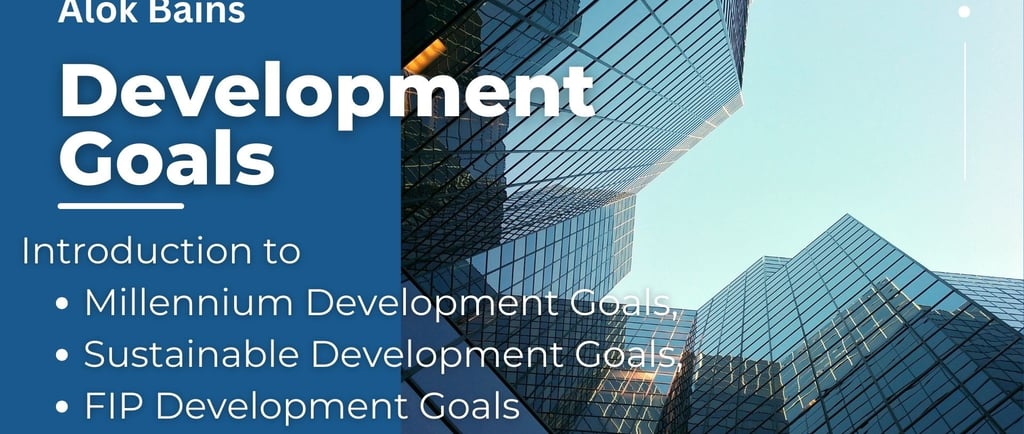Development Goals
Introduction to Millennium Development Goals, Sustainable Development Goals, FIP Development Goals
SOCIAL PHARMACY
Alok Bains
10/25/20233 min read


Introduction to
Millennium Development Goals,
Sustainable Development Goals,
FIP Development Goals
Introduction to Millennium Development Goals (MDGs)
Members of the United Nations signed a Millennium Development Goals in September 2000. They were set of eight international development goals. They were designed to address a range of global challenges and to improve the living conditions of people in developing countries. The MDGs aimed to achieve by 2015.
The following are eight MDGs
1. To eradicate extreme poverty and hunger
2. To achieve universal primary education
3. To promote gender equality and empower women
4. To Reduce Child Mortality
5. To Improve Maternal Health
6. To combat HIV/AIDS, malaria, and other diseases
7. To ensure environmental sustainability
8. To develop global partnerships for development.
The Millennium Development Goals were succeeded by the Sustainable Development Goals in 2015.
Sustainable Development Goals
Sustainable Development Goals are also called Global Goals. These Goals were designed by the United Nations in 2015. These goals are designed to address a wide range of global challenges. It was designed to be achieved by 2030. There are seventeen Sustainable Development Goals.
1. No poverty: Ends of poverty in all its forms everywhere.
2. Zero Hunger: End hunger, achieve food security, and promote sustainable agriculture.
3. Good Health and Well-being: Ensure healthy lives and promote well-being for all at all ages.
4. Quality Education: Ensure equitable and inclusive quality education. Promote lifelong learning opportunities for all
5. Gender equality: Achieve gender equality and empower all women and girls.
6. Clean Water and Sanitation: Ensure the availability of sustainable management of water and sanitation for all.
7. Affordable and clean energy: Ensure access to affordable, reliable, sustainable, and modern energy for all.
8. Decent Work and Economic Growth: Promote sustained and inclusive economic growth, productive employment, and decent work for all.
9. Industry, Innovation, and Infrastructure: Build infrastructure, promote inclusive and sustainable industrialization, and foster innovation.
10. Reduced inequality: Reduce inequality within and among countries.
11. Sustainable Cities and Communities: Make cities and human settlements inclusive, safe, flexible, and sustainable.
12. Responsible Consumption and Production: Ensure sustainable production and consumption patterns.
13. Climate Action: Take urgent action to combat climate change and its impact.
14. Life Below Water: Conserve the oceans, seas, and marine resources for sustainable use and sustainable development.
15. Life on Land: Protect, restore, and promote sustainable use of terrestrial ecosystem, sustainably manage forests, combat deforestation and halt biodiversity loss. Halt and reverse land degradation.
16. Peace, Justice, and strong institutions: Promote A peaceful and inclusive society for sustainable developments, and provide access to justice for all. Build effective, accountable, and inclusive institutions at all levels.
17. Partnership for Goals: Strengthen the means of implementation and revitalize the goal of partnership for sustainable development.
FIP Development Goals
The International Pharmaceutical Federation (FIP) launched 21 Development Goals in September 2020. These goals aimed to transform the pharmacy profession globally, regionally, and nationally over the next decades. FIP development Goals support pharmacy transformation by bringing three components together 1) Pharmaceutical Practices, 2) Science, and 3) Workforce and education together. It is in alignment with the Global UN Sustainable Development Goals.
These 21Goals consist of three elements: 1) Pharmaceutical Practices, 2) Science, 3) Workforce and education. The following are the 21 FIF Development Goals
1. FIP Development Goal 1: Academic capacity
2. FIP Development Goal 2: Early career training strategy
3. FIP Development Goal 3: Quality assurance
4. FIP Development Goal 4: Advanced and specialist development
5. FIP Development Goal 5: Competency development.
6. FIP Development Goal 6: Leadership development
7. FIP Development Goal 7: Advancing integrated services
8. FIP Development Goal 8: Working with others
9. FIP Development Goal 9: Continuing professional development strategies
10. FIP Development Goal 10: Equity and equality
11. FIP Development Goal 11: Impact and outcomes
12. FIP Development Goal 12: Pharmacy intelligence
13. FIP Development Goal 13: Policy development
14. FIP Development Goal 14: Medicines expertise
15. FIP Development Goal 15: People-centred care
16. FIP Development Goal 16: Communicable diseases
17. FIP Development Goal 17: Antimicrobial stewardship
18. FIP Development Goal 18: Access to medicines, devices & services
19. FIP Development Goal 19: Patient safety
20. FIP Development Goal 20: Digital health
21. FIP Development Goal 21: Sustainability in pharmacy.
Alok Bains
